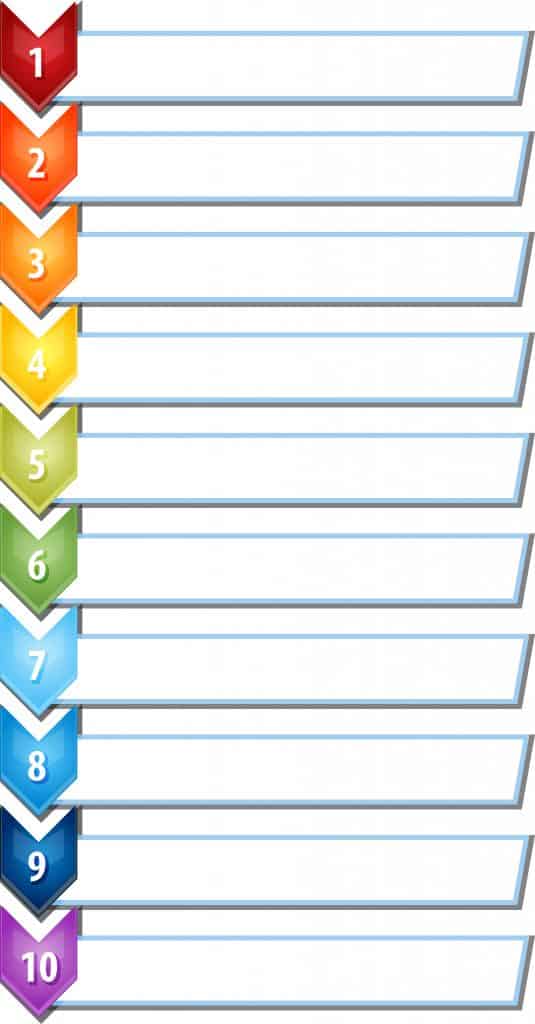
A Step-By-Step Content Audit Guide

You’ve made the smart choice to outsource content writing to a professional agency. Your time and effort are finally free for your brand’s core pursuits. Before you buy articles, however, take stock of the content you already have and brainstorm how you can repurpose these assets to your advantage. A full SEO content audit is both a first and an interim step for any comprehensive content marketing strategy. Use this content audit guide to streamline your audit and gather a complete picture of your organization’s existing content assets.
What Exactly Is a Content Audit?

Many organizations mistake a content audit, which should be qualitative, with an inventory, which is a simple quantitative list of the existing assets. With an audit, you should actually delve into each publication to ensure it meets the key performance indicators for your brand. Single Grain notes that you should be able to answer the following questions as a result of an appropriately in-depth content audit:
- Which posts have done the best job of engaging and connecting with my audience?
- Which posts have shown the top performance?
- Are there posts that have not performed up to expectations?
- Which posts no longer dovetail with the brand’s KPIs?
The answers can help you focus your content marketing to impact your goals and ultimately improve SEO for your brand. Other benefits of a thorough content audit include:
- Identifying content that must be optimized with features like metadata and tags
- Finding assets you can reuse and repurpose, a strategy that can dramatically stretch your content writing budget
- Refreshing old content that follows obsolete SEO standards or includes outdated information
- Removing broken and poorly performing URLs from your site
- Ensuring a consistent tone and reading level across your content
- Understanding the strengths and weaknesses of your inventory so you can improve the value and performance of your content
- Reviewing the readability and format of your content so your site remains accessible for all members of your audience
- Providing insight that you can use to create or update your brand’s style guide
- Informing smart workflows for content production
- Gathering the information you need to seek content strategy buy-in from organizational leaders
The bottom line? If you publish content, you can benefit from an SEO content audit unless you plan to scrap your existing site and start from scratch.
7 Steps To a Successful Content Audit
While analyzing all your published content across online channels may seem like an insurmountable task, completing a content audit will result in a more cohesive, engaging experience for your audience. The details you obtain will help you devise a focused, effective content marketing strategy. Use this step-by-step guide to get to the other side of the content audit hurdle.
1. Establish Goals and Plans
The first step is to make a plan. What do you want your content to accomplish, and how can you get there? Answering this question before you learn how to audit your content will help you understand how well your existing assets serve your brand’s mission and vision.
Common goals for a content audit include eliminating outdated assets, gathering ideas for future content to plan your editorial calendar, locating content gaps at each section of the sales funnel, identifying the best-performing types of content or improving your site’s performance in organic search.

First, write down two or three content strategy or SEO goals you hope to achieve with your audit. For best results, use the SMART framework, which means your goals should be Specific, Measurable, Achievable, Relevant and Time-Bound. A standard goal might be “Boost your site’s search engine rankings,” while a SMART goal would read “Improve the site’s search engine rankings by at least 15% by March 1, 2021.”
Once you have your SMART goals in place, list the steps toward each goal. For example, the steps for your SMART goal above might include:
- Review the performance of your current assets through a website content audit.
- Repurpose high-performing assets through a refresh and revision.
- Remove underperforming assets as well as those that do not support your brand message.
Then, when you get to step 3 below, choose appropriate metrics to inform the goals of your content audit.
2. Create an Inventory
Now, make a spreadsheet that includes the page title and URL for every content asset on your brand’s website. Depending on the depth of your current content, you may want to stay organized by grouping pages by headers and subheads. If you already have a significant amount of content, assigning numbers to each piece can help keep similar items straight.

While there’s no right or wrong way to create a content inventory, including robust information will improve the usefulness of this document. Marketing Land suggests building out your content inventory spreadsheet with:
- The original publication date of each asset, along with any updates along the way
- The source of each asset, whether you outsource content writing, create assets in-house or a combination of these approaches
- An internal individual or department responsible for each asset, if applicable
- The type of content
- The length of the asset
- Whether the asset includes ancillaries such as images, video and infographics
- Stage in the sales funnel, whether the content targets individuals in the awareness, consideration or decision stage
You don’t have to pull all this data on your own, especially if you already outsource content writing and have developed a significant asset library. Most marketing experts recommend using a site indexing tool like Trim, Screaming Frog or SiteOrbiter.
3. Review Content Metrics
To improve the performance of your brand’s website, you need a benchmark to use as a starting point. Quick Sprout recommends gathering the following data as it applies to each of the content assets listed in your inventory:
- Total social shares on platforms including Facebook, Twitter, Instagram, LinkedIn and others as appropriate
- URL rank for authority using a content audit tool such as Ahrefs
- Number of backlinks, which influences the authority ranking of your site and can also be gathered from Ahrefs
- Average amount of time visitors spend on the page
- Bounce rate for each page
- Overall traffic and organic search traffic for each page
- Search volume and ranking for each page’s main keyword
- Sources of traffic for each page
- Conversion rate for each page
Get Specific With Your SEO Content Audit
If you have limited time or few content assets, you may want to choose just two to three metrics to measure for a truncated content audit. Most of these details are available through Google Analytics, so install that tool to start gathering data on your website performance if you haven’t already. Some content management platforms, such as WordPress, offer integrated analytics.

Based on your goals, you may want to go back to your inventory and highlight sites with specific issues to be addressed in your content audit. For example, Content Marketing Institute notes that if your audit needs to occur on a tight deadline, you should focus the bulk of your work on pages with high bounce rates, low traffic and low conversions despite high traffic.
4. Develop a Rating Scale
Just like when you declutter your home, decluttering your brand’s content requires you to categorize your existing assets. Some experts recommend using a “keep, revise or delete” format for the content audit. The keep category describes content that supports your brand message, performs well and does not require a refresh. Assets categorized as revised can be removed and republished with changes such as optimizing for SEO and removing outdated information. Delete assets that no longer support your brand message and have no potential value as repurposed content. You can also score each content asset from 1 to 5 or use any other rating scale that makes sense to you. However, choose a simple system to avoid overcomplicating the website content audit process.
5. Analyze and Score Each Content Asset
As you review each piece of content, you need to decide where it falls on your rating scale. The answers to some or all of these questions should factor into your content rating:
Does the Content Support a Business Goal?
To engage in effective content strategy, each of your publications should directly influence one of your key business objectives. When content does not fit into a target area, it can distract from your brand’s message. Delve into the meat of each asset to see what the content is actually about and whether it delivers on the promise of the title, H2s and metadata.
Does the Content Have Obsolete Information?
Common culprits include statistics, industry data, pricing details and other information that tends to change over time. If your company’s mission and vision have evolved, content may also become outdated because it no longer meets the brand’s core objectives and values. This will be important to note in your content audit.

Does the Content Need a Makeover for Tone, Voice, Style and Consistency?
Proofread every item to make sure links work, correct spelling and grammar, and standardize abbreviations and acronyms. If you have a style guide, make sure each asset follows its provisions. All content should be logically organized, easy to understand and audience-appropriate.
Are Users Finding and Reading the Asset?
If the web analytics for a piece of content show poor performance, it needs an overhaul if you plan to keep it. On the flip side, top-performing assets should serve as inspiration as you refresh less-impressive assets and outsource content writing to invest in new assets.
Is the Asset Optimized for SEO?
Every content item should include, at minimum, image tags, headings and subheadings, metadata, keywords, image and multimedia file captions, and search-optimized headlines.
6. Look for Gaps and Get Creative
After scoring each and every content asset, zoom out and look at the big picture. Are chunks of information absent from your content strategy? Does your content fail to address one or more of the target audiences for your brand? Where can you bolster your content offerings to better serve your readers? Once you answer these questions, it’s time to outsource content writing so you can buy articles to fulfill the potential of your carefully crafted content marketing plan.
Not every hole in your content strategy requires a brand-new article. In fact, you can save money and create new streams of profit when you outsource content writing by repurposing old assets into new types of content. This is why conducting a content audit can save you time and effort.
For example, gather several blog posts together and add some new information, then release the result as a white paper or e-book. In a 2019 study by SEMrush, content assets that exceed 3,000 words achieved an average of 400% more shares, 350% more backlinks and 300% more traffic compared to shorter content assets.
In a 2019 study by @SEMrush, content assets that exceed 3,000 words achieved an average of 400% more shares, 350% more backlinks and 300% more traffic compared to shorter content assets. 🤯 #ContentMarketing #Marketing Share on X
7. Make an Action Plan

According to the Content Marketing Institute, one of the most common SEO content audit mistakes is the failure to translate all that data into an actual improvement of your brand’s content strategy. In addition to categorizing each asset or giving it a numerical score, make careful notes for items that need minor revision or a major overhaul. This document can serve as an action plan when you’re ready to outsource content writing.
SEMrush recommends prioritizing your content audit action plan before you outsource content writing. Start with items that need just a little bit of work, like updating links, adding metadata or replacing old statistics with new numbers. After addressing this low-hanging fruit to quickly and effectively optimize your site, move on to content that needs a more thorough rewrite.
A website content audit requires a significant amount of work, but that doesn’t make it a one-time project. Conducting a regular content audit will help ensure that your investment in content delivers real value for your brand, whether that means more traffic, more conversions or a better SEO ranking. After this initial audit, create a content calendar that covers the next six to 12 months, with milestones to check the performance of new and existing content.
Ready To Outsource Content Writing?
Completing these seven essential SEO content audit steps before you outsource content writing can improve your chances of seeing an impressive return on this marketing investment. If you’re prepared to move forward, browse the BKA Content Shop or get in touch with us today to learn more about how our professional writers can revise, refresh and revitalize your brand assets in accordance with the results of your content audit.
- How To Use Keywords in Your Content for SEO - September 20, 2024
- Creating Google-Friendly Content - December 31, 2023
- Which Type of Content Brings In the Most Traffic? - December 28, 2023

